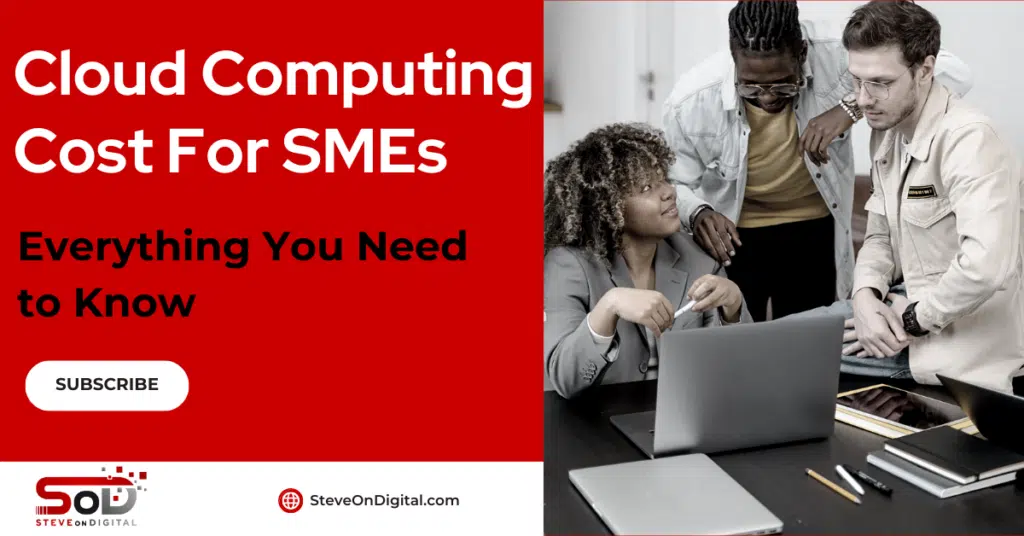Cloud Computing Cost For SMEs – Everything You Need To Know

As a digital transformation specialist with a rich background in electrical engineering, an MBA, and a master’s in project management, I’ve leveraged cloud computing not just as a concept but as a practical solution to numerous challenges faced by small businesses. My journey, shared through various platforms such as SteveOnDigital, aims to demystify the digital landscape for small business owners, offering insights drawn from real-life scenarios. Definition And Basics Of Cloud Computing Cloud computing, a term that echoes through the corridors of the digital transformation landscape, is an indispensable tool for small and medium-sized businesses like yours and mine. Cloud computing lets companies use tech resources like servers, storage, and software over the internet. This means businesses can innovate quicker, adjust resources as needed, and save money when they scale up. This means you can use what you need when you need it, and pay only for what you use. Advantages For Small Businesses: Cost Efficiency, Scalability, Flexibility For small businesses, the leap into cloud computing services is not just about keeping up with technology trends; it’s a strategic move towards cost efficiency, scalability, and flexibility in business operations. These advantages are not mere buzzwords but tangible benefits that I have witnessed firsthand: Comprehensive Cost Analysis Overview Of Cloud Computing Costs Key Factors Influencing Costs The cost of cloud computing for small business varies widely and is influenced by several factors: Pricing Models Explained The common pricing models in cloud computing include: Detailed Cost Breakdown Cloud Services: Storage, Compute, Networking Breaking down the costs associated with cloud computing: Direct vs. Indirect Costs: Understanding The Full Spectrum Besides the direct costs (storage, compute, networking), it’s essential to consider indirect costs, which might not be as apparent: Deep Dive Into Cloud Costs In the journey of managing SteveOnDigital, I’ve navigated through the sea of cloud computing, evaluating every cost component that small businesses should be aware of. This deep dive into cloud costs will help you understand where your funds are going and how to manage them effectively. Specific Cloud Costs Storage Costs: Strategies And Pricing The cost of storing data in the cloud is one of the most straightforward expenses to understand yet varies widely among cloud providers. Cloud storage costs are primarily based on the amount of data stored, the storage class (for instance, standard, nearline, coldline, or archive), and the network usage to access this data. From my experience, adopting strategies like tiered storage, where you store less frequently accessed data in cheaper, slower storage classes, can lead to substantial cost savings. Moreover, considering the data retrieval costs and minimum storage duration charges is crucial for effective budgeting. Compute Costs: Virtual Machines And Instances Compute costs refer to the expenses associated with processing power in the cloud. These costs can significantly fluctuate based on the type of virtual machines (VMs) and the instances you deploy. The choice between on-demand instances, which offer maximum flexibility, and reserved instances, which provide cost savings for long-term commitments, is pivotal. My strategy has always been to start with on-demand instances to gauge my needs accurately and then shift to reserved instances for workloads with predictable usage to enjoy discounted pricing. Networking: Managing Data Transfer And Bandwidth Networking costs, often overlooked, include expenses for data transfer and bandwidth usage. These costs can accumulate, especially when data is frequently moved between different cloud services or to and from the internet. To minimize these costs, it’s beneficial to select cloud providers that offer free ingress or egress within the same region or have lower data transfer fees. Also, using content delivery networks (CDNs) can reduce bandwidth costs while improving application performance. Cloud Computing Cost Factors Cost Factor Description Implications for Small Businesses Storage Costs Fees for storing data in the cloud, influenced by volume and type of storage Optimize storage types to balance access with cost Compute Costs Charges based on the processing power required by applications Rightsize instances to match workload demands Data Transfer Fees Costs associated with moving data in and out of the cloud Consider cloud providers with lower data transfer fees or free tiers Network Costs Fees for using the cloud provider’s network resources Use CDNs and efficient data routing to reduce costs Managed Services Additional fees for managed services like databases, machine learning, etc. Use managed services to reduce the need for in-house expertise Security and Compliance Costs for enhanced security features and compliance certifications Essential for protecting sensitive data; consider as part of total cost of ownership Additional Costs And Considerations Managed Services, API Access, Disaster Recovery Beyond the basic components of cloud costs, small businesses must consider expenses related to managed services, API access, and disaster recovery. Managed services, where the cloud provider manages certain aspects of the cloud environment, can introduce additional costs but also significantly reduce the burden on your IT team. Similarly, using APIs for automation or integration can incur charges, but they often enhance operational efficiency. Moreover, implementing a robust disaster recovery plan is essential for protecting critical data, though it adds to the cloud budget. Cloud Spending Optimization Optimizing cloud spending is not just about cutting costs but ensuring you’re getting the most value out of your cloud investment. Here are strategies that I’ve personally found effective in managing cloud expenses. Effective Cost-Saving Strategies Rightsizing Resources For Efficiency Rightsizing involves adjusting your cloud resources to match the demand accurately. It’s about finding the balance between performance and cost. This process requires regular monitoring and analysis of your cloud usage to identify underutilized resources that can be downscaled. Adopting autoscaling can also help adjust resources dynamically, ensuring you’re not overpaying for unused capacity. Leveraging Reserved Instances For Discounts As mentioned earlier, reserved instances offer significant cost savings compared to on-demand pricing, in exchange for committing to a specific level of usage for a set period. By analyzing your cloud usage patterns and committing to reserved instances for consistent workloads, you can achieve substantial cost savings. Utilizing Free Tiers Wisely Most cloud providers offer a

